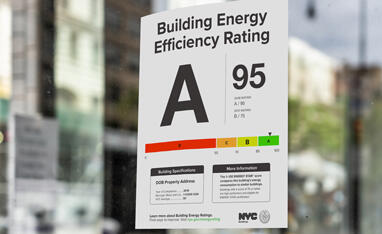For now, New York City’s Benchmarking Law requires property owners to submit their energy usage data and display their energy efficiency grade without any financial consequences, but the city’s energy regulations are expected to become more demanding in the years to come in order to meet its ambitious climate goals.
That makes it critical for multifamily building owners and managers to get ahead of the curve and start to tackle the kind of longer-term energy efficiency upgrade projects that lead to significant gains in performance.
Long-term investments are the best way to guarantee a positive grade for years to come. These may cost more initially, but they guarantee consistent cost savings after the initial payback period.
By creating a plan now, building owners can avoid the compounding of high costs later when such upgrades become necessary for compliance.
National Grid’s Benchmarking Program helps every step of the way, including no-cost consultations and incentives that shorten the payback period.
First, a representative from National Grid’s energy partner, Leidos, will conduct a walk-through to assess the building’s current energy efficiency compared to similar buildings. Second, they’ll provide a detailed report with recommendations for optimizing performance. In addition to identifying easy no/low-cost upgrades that owners can implement right away, they’ll create an action plan for the large capital improvements that offer big energy savings over the long-term but require investment and budget approval to implement. These big capital projects should be started as soon as possible to improve the efficiency of your building.
In addition to cost and energy savings, these types of projects can help companies engage staff in their energy efficiency initiatives, contribute to established environmental organization goals and reduce the company’s environmental footprint, all of which are crucial today.
Some of the capital projects that can translate to major cost and energy savings for multifamily buildings include upgrading to new high-efficiency boilers, furnaces and water heaters. Adding a combustion control system or heat recovery unit and variable frequency drive pumps could be other big projects to consider.
Some of these larger projects are available through National Grid’s prescriptive incentive measures, which offer incentives on more energy-efficient equipment. These include:
- Hydronic boilers from 1001-3000 MBH: Hydronic systems require less energy to heat than traditional boilers because water is a better heat conductor than air. They are also sealed systems, resulting in fewer emissions. The result: more than 85% thermal efficiency. Incentives range from $2,500 to $3,000.
- Condensing boilers 1001-3000 MBH: Because these operate at lower temperatures than traditional boilers and therefore don’t need to vent excess heat, they consume less energy and keep more heat in the heating system, resulting in more than 92% thermal efficiency. Incentives range from $8,000 to $12,000.
- Steam Traps: Steam traps are also often overlooked, but a constant focus on replacing or repairing failed steam traps can yield significant energy savings. Steam Traps are eligible for rebates of $100 each, with a limit of 250.
- Pipe Insulation: A well-insulated system includes insulation for pipes, valves, boilers, steam drums, and outside duct work. Hotter surfaces without insulation can result in up to 20 times more heat loss than those with insulation. Pipe insulation over 2 inches in diameter may be eligible for custom rebates.

For energy-saving upgrades not covered by prescriptive incentives, National Grid offers custom incentives. Pre-approved projects receive a one-time incentive based on estimated first-year savings that cover up to 70% of project costs. Among the eligible equipment:
- Energy monitoring systems: These connect to electricity meters, providing a snapshot of current energy usage and alerting you to equipment that is consuming more energy than expected.
- Insulation for processes and non-building envelope improvements: Building envelope improvements (measures that regulate heat transfer) such as energy efficient wall, attic and roof insulation, and windows may be eligible for custom rebates at an increased incentive of $11 per therm. These pre-approved weatherization projects receive a one-time incentive based on estimated first-year savings up to 70% of project costs to a maximum of $100,000 in Long Island and the Rockaways and maximum of $200,000 for projects in New York City. Other building envelope improvements may also qualify.
- Heat recovery units: Heat recovery units recycle warm air to make boilers work more efficiently.
- Heating equipment: Any larger sized heating equipment than those offered through the prescriptive program.

National Grid can help with board approval
By identifying the pain points the upgrades will solve and their positive impact on overall building value and long-term tenant satisfaction, owners will find the detailed reports and action plans they receive through the Benchmarking Program an invaluable resource when they seek approvals from the property board for large capital projects.
These reports can play a key role in helping you position the multifamily property’s energy strategy in a way that appeals to the board of managers. Like any business, having an analytical framework that includes an investment plan and expected return on investment (ROI) will have a greater impact on these decision-makers. Getting to the high-level points immediately is important, communicating precisely how this investment will have an impact on the building’s long-term value.
In the context of the NYC Benchmarking Law, property managers should focus not only on the financial impact this will have, but also on the not as easily quantifiable factors, such as overall building value and long-term tenant satisfaction. Another important case for the financial benefits of these long-term investments is the amount of money and time that may be going into ongoing maintenance for outdated systems. Not only does replacing these systems with newer, more energy-efficient systems save money on direct energy costs, it can greatly ease the financial and operational burden of ongoing system repairs.
Conclusion
Every multifamily building is unique and will require a different approach to improving building grades and becoming more sustainable. With new local rules and regulations emerging every year, now is the ideal time to take action. Learn more about National Grid’s Benchmarking Program.

